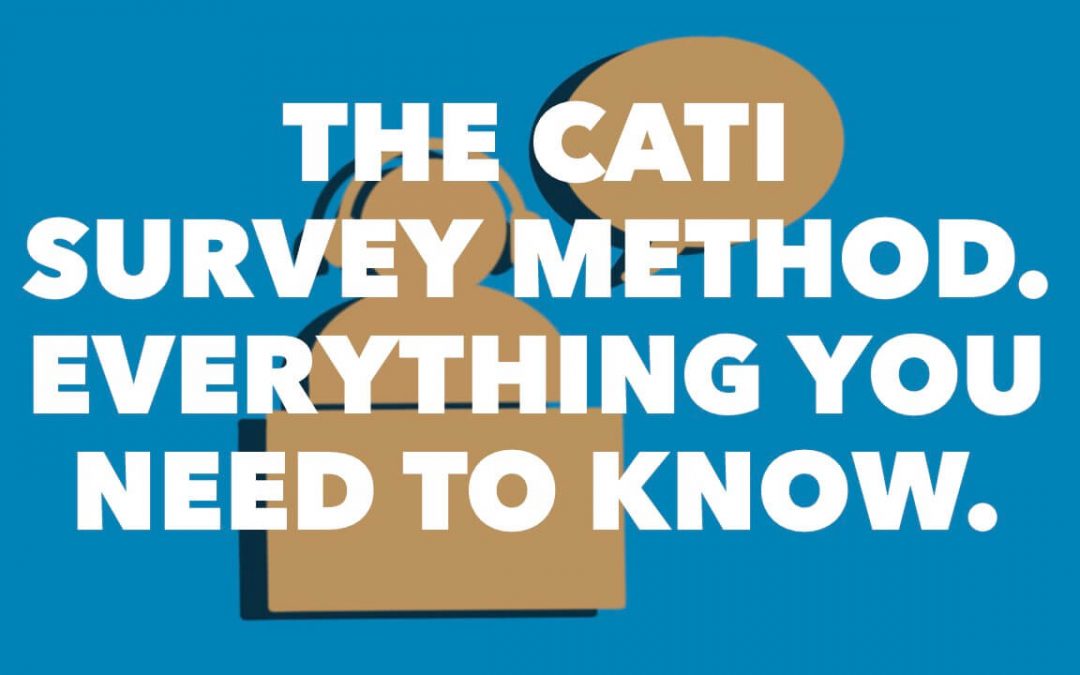Research is a crucial aspect in which a business may obtain the necessary data to make informed decisions. Many research models on the market have made data gathering significantly more accessible and more effective.

With the advent of computerized learning and AI, data gathering has become more manageable and streamlined. Companies invest time and other resources going through several research approaches and conducting viability studies to see if their chosen method is viable.
Computer-assisted Telephone Interviewing (CATI) software is one approach that may be used for automated polling, which allows you to conduct surveys via a computer. This article will discuss everything you need to know about the computer-assisted telephone interviewing (CATI) survey method to decide if this is the correct method for you.
What Is CATI?
Computer-assisted Telephone Interviewing (CATI) is a form of automated survey that uses software to provide the interviewer with a script. It’s a method of collecting data via phone that speeds up the data collection and updating and allows the interviewer to educate respondents on the importance of timely and accurate data.
In the same way that computers have taken the place of clipboards and questionnaires in face-to-face research, CATI has substituted traditional telephone interviews. The interview is conducted over the mobile phone and is guided by a questionnaire that appears on the computer screen. The CATI interviewers enter replies on the keyboard to match the pre-coded answers that appear on the screen.

Also, the interviewer may read from a computer screen in the same manner as from a paper questionnaire, and data is immediately submitted to a system that keeps all answers for later analysis. The main advantage of the CATI system is that the participant is automatically routed through the questionnaire based on their responses, reducing the risk of human error and allowing invalid survey questions to be avoided.
In addition, the outcomes of each call may be viewed in real-time, which is beneficial for project and sample management, resourcing, and getting a sense of a set of findings before fieldwork has ended. The CATI methodologies also eliminate the need for data exchanged from paper to electronic formats for analysis, saving time and avoiding mistakes.
CATI Surveys
Computer-assisted telephone interviewing (CATI) survey is a type of quantitative market and public opinion research that employs computer-assisted technologies. CATI research is one of the most frequently used quantitative research approaches. A trained interviewer uses a respondent to answer a series of questions over the phone.
How Is The CATI Survey Conducted?
Companies utilize a computer script that has been carefully prepared to ensure that it is adequately ready. An automated questionnaire allows the interviewer to track all questions during a telephone conversation. The CATI survey approach includes various tools to regulate and use information about respondents to tailor the questions appropriately.

A survey questionnaire that is correctly structured eliminates incorrect or illogical answers that may have been submitted inadvertently. This is a significant benefit over traditional spreadsheets since it allows you to avoid errors, lowering the chance of irrelevant surveys.
How Does CATI Research Work?
Computer-assisted Telephone Interviews, or CATI survey techniques, are used by many prominent businesses to gather important information that may assist them in growing their brands. Researchers and institutions may also utilize CATI software in their studies, collecting data for academic research.
However, the CATI approach’s flexibility makes it simple to apply to a wide range of projects and circumstances in the following ways:
1. Ease of Use for Phone Representatives
The CATI survey approach makes it simple for interviewers to go through the interview without requiring any technical expertise or training. As a result, the interviewer may focus on the interviewee and gather accurate information.

Operators may reach interviewees in seconds instead of minutes, thanks to features like Click to Dial, which allow them to connect callers without dialing manually. Productivity may be improved with the ability to program Predictive Dialing, allowing the switchboard to call numbers automatically.
2. Key Administrative Features MakeDo Surveys a Snap, 24 Hours a Day
The CATI method software is adaptable, user-friendly, and versatile enough that interviewers may do research surveys at any time of day or night across the world. CATI software program is designed to automatically calculate the time difference between two locations and automatically adjust the interviewers’ and respondents’ time zones.

Also, it allows project managers to monitor interviewers’ efficiency through statistics, response rate, and productivity settings and define distinct outcomes for phone surveys. Furthermore, both inbound and outbound calls can be managed using management tools. This collection of features makes telephone survey projects simple and effective.
3. CATI Survey Method Can Be Modified to Specific Needs
The CATI survey method allows users to customize the telephone interviewing tools to meet the project’s specific requirements. Users may create their surveys to combine features and options in innovative ways.
The CATI CAWI (computer-assisted web-interviewing) mixed-mode option allows you to start a survey by phone and have the participant complete it on the web. Users can access the CATI software program directly from a web browser without additional software.
Appointments and notes can be viewed on the screen as needed. The CATI survey approach makes your computer-assisted phone interviewing quick, easy, and practical while also providing high-performance tools for gathering critical information.
The Importance of Understanding the Benefits and Challenges of a CATI Survey Research
One of the first major decisions you’ll have to make when conducting market research is which type of approach to use. You can go with web-based or face-to-face surveys, but phone interviews are still helpful. Consider the benefits and shortcomings of each method before choosing one.

A CATI survey might be the ideal answer for your data collection. You can conduct customer satisfaction surveys, market research, sample management, political polls, social research, and other CATI surveys. With the appropriate software programs like Rotator survey, you’ll have all you need to conduct an effective and thorough investigation.
Choose a CATI software program that offers you many licensing options and not simply features since you don’t want to over-invest.
Benefits of CATI Survey Research
CATI is a computer-assisted telephone interview system that improves traditional voice call methods, which employ a pen-and-paper method to evaluate survey questions and record responses.
A CATI software program securely stores data, allowing interviewers to concentrate on the interview rather than other things like survey routing. However, the following are some of the advantages of using a CATI survey research:
1. Cost and Time Effective
Compared to other methods of gathering data, such as direct mail, telephone interviews are more cost-effective. For example, a 10-minute phone conversation may be quite affordable with most phone plans. Therefore, it is not difficult for a small business to complete 300 or 400 surveys.

On the other hand, direct mail is not as efficient as online surveys. It is more expensive to use in conducting survey research. Many companies will have to mail out many more surveys to reach the 300 or 400 they need since not everyone will complete or return them.
However, telephone surveys can be completed in a matter of minutes. All you have to do is keep calling until you reach your target. Other techniques, such as direct mail and internet surveys, provide less influence since the results might take months to arrive.
2. Good Quality Assurance
Interviewers who have been trained may similarly ask questions to ensure that the responses are accurate and precise. The phone interviews are also recorded, allowing the interviewer to observe and evaluate respondents’ attitudes and behaviors on contentious issues (such as state squabbles, preferred presidential candidates, and so on) or new ideas (new products, legislation to be passed, etc.).
3. Quick Data Processing and Management
The development of CATI has resulted in a more efficient process of collecting, processing, and storing data from phone interviews. CATI can be used to examine real-time data and past data quickly.
4. Wide Geographic Access
Small company owners may conduct interviews by phone across several states. Almost everyone in the United States has a landline phone or smartphone, and most of these numbers can be obtained for a fee from telephone companies.

In-house or internet phone directories are also accessible to phone interviewers. This enables researchers to contact and interact with almost any customer. A small restaurant company, for example, may gather consumer feedback in all 10 of its major markets in a four-state region.
Challenges of CATI Survey Research
1. Time Constrained Interviews
Interviews by phone should not exceed 10 minutes because they may interfere with the respondents’ time. This necessitates converting a single open-ended question with a lengthy response into a few close-ended questions.
2. Unseen Product
A face-to-face interview is preferable to a phone survey when studying consumers since responses may be more readily elicited when individuals see, feel, or taste the product.
3. It Isn’t Easy to Establish a Connection.
Phone interviews may be difficult for business owners to connect with their customers. They cannot observe the individuals they are meeting with, for example.

Thus, they can’t read people’s reactions to determine whether the replies are truthful since they don’t have a clear idea of what reactions signify. In contrast, in-person interviews are the polar opposite: interviewers may check respondents’ faces and gestures to determine whether their replies are genuine.
4. Intrusive to Customers
Another disadvantage of phone interviews is that they may be distracting. Calls are most frequently made at random, often interrupting individuals’ dinners or evenings. As a result, participants may put down the phone before the interview is finished or choose not to participate in the survey research.
5. Limited Complexity of Questions
It isn’t easy to get people to expand their responses over the phone. Most phone interviews have a time limit of five or ten minutes. People hang up during more extended interviews, leaving some unanswered questions. As a result, companies that conduct phone interviews typically keep their questions and answers to a minimum.

Rather than being open-ended, many of these questions must be multiple-choice. The open-ended questions are more valuable since they allow customers to explain why they picked the options they did on multiple-choice questions.
CATI Software in Mixed Mode
There are many approaches that researchers use to interview people, which include the following:
- Telephone interviewing (CATI)
- Online questionnaires (CAWI)
- In-person interviews using smartphones, tablets, or laptops (CAPI)
- Mail surveys
Sometimes the most effective approach to contacting someone is to employ two or more of these techniques at once. For example, combining phone interviews with a web survey may be the most convenient and inexpensive method to contact people for a specific project.

The mixed-mode survey approach may provide the cost and speed benefits of online surveys while still reaching people who don’t have access to the internet. It is an excellent option for survey software that works online and offline. A mixed-mode survey may display both the combined results and comparisons of the findings from each data collection method.
Why a Mixed-Mode Approach?
Since respondents have more options and freedom, mixed-mode surveys are becoming increasingly popular among researchers. The convenience and accessibility of the internet and the widespread use of email have encouraged people to take more online surveys.
However, researchers can now choose the most efficient marketing approach to target customers, whether by phone or mobile phone, paper “snail-mail” questionnaires, email communications, and online questionnaires, among other options.

This feature allows researchers to personalize a survey by selecting the best approach for various sections that were not possible previously. Researchers can increase the coverage of their target population in multiple ways, and, perhaps more importantly, participants may respond in more significant numbers.
Participants who are frequently unwilling to participate in internet surveys may be more receptive after being contacted by phone for the first time. In addition, providing participants a choice of how to provide feedback generally raises response rates.
It’s also crucial to remember that, in some cases, mixed-mode surveys may be more cost-effective than one-on-one interviews. Most customer research surveys used to be completed exclusively over the phone, but they may now be done partially online, saving clients money and time.
FAQs
What Is the CATI Survey Method?
The term “CATI” refers to Computer-Assisted Telephone Interviewing. CATI is a type of survey that can be done via phone calls using a computer-assisted method, such as CATI software on a computer or mobile device.
Interviewers in the CATI method use CATI software to run a survey, record responses, and monitor response and completion rates. The CATI software program contains the survey design, including the entire questionnaire and related instructions and survey routing or logic.
What Is the Difference Between CAPI and CATI?
CATI stands for “computer-assisted telephone interview,” and it’s a kind of program employed in centralized call centers. In this instance, interviewers call potential respondents at their homes or businesses, with respondents representing the population.
The CAPI is an acronym for “computer-assisted personal interview.” This interview form is mainly done in person at the homes or businesses of potential participants or mall intercept centers.
What Are Outbound and Inbound Calls?
Outbound; specific surveys may necessitate a different approach for call center respondents to contact the center. But when you use inbound, the dialer automatically connects you to the first available interviewer. The interviewer may take over and begin the interview after searching and identifying the respondent in the software database.

You can run the survey in mixed mode. The outbound-inbound method is typically utilized to handle calls that the call center receives after a failed phone attempt. People frequently return the number to find out who called them. The rings may also be retrieved in mixed mode.
How Do I Set up an Automated Phone Survey?
A telephone survey (Computer Assisted Telephone Interviewing) gathers data through phone agents who contact people to ask questions. The mobile number is shown immediately in the CATI interface to the representatives and may be dialed with click-to-dial, automated, or predictive dialing. The interviewer’s script is on the screen, including an introduction to the survey, a questionnaire with many questions, and a conclusion.
The software may also develop and implement call dispositions, delays, quotas, and appointment scheduling for respondents. The administrator may use the CATI platform to collect data and specify how data is effectively managed, attempts performed, and scheduled appointments.
Final Word On The CATI Survey Method
Information is urgently needed, and CATI has become essential in social sector research. This is the time to look at possible data collection techniques, and CATI has a good chance of being a showstopper in this case.


